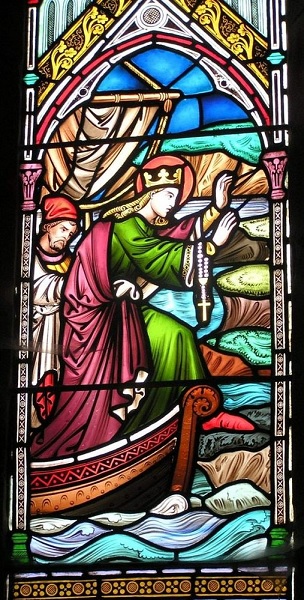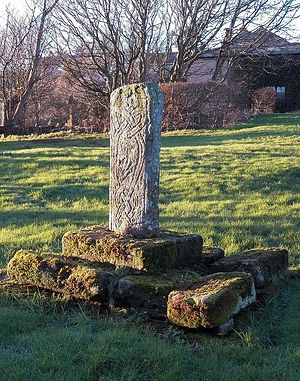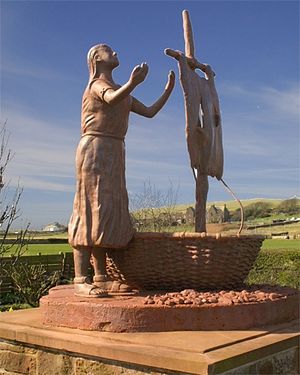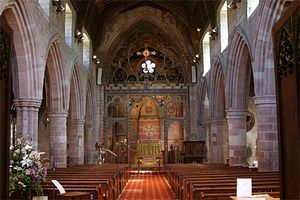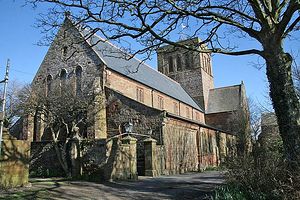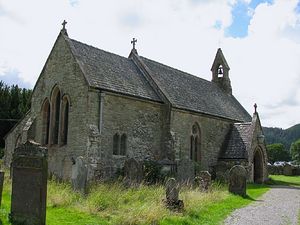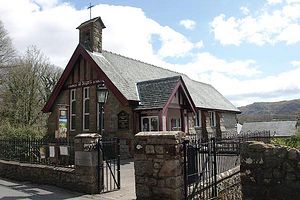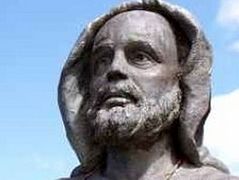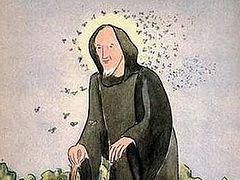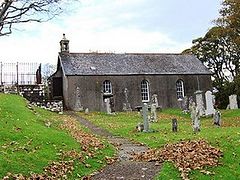St. Bega (other forms of her name are Begh and Bee) is said to have been Irish, though it is not clear whether she lived in the eighth or ninth century. In any case she was a virgin who led a holy life in north-western England. The legend says that she was an Irish princess, the most beautiful in her kingdom, who fled from her native land to avoid marriage with a pagan Viking—a Norwegian prince. Guided by an angel, Bega refused a pagan husband, as she wanted to devote her life to the Heavenly Bridegroom—Christ. Having crossed the Irish Sea and survived shipwreck, she was thrown ashore in the area to the south of the present-day Cumbrian town of Whitehaven in Copeland (in the north-west of England). Seeing in this a sign from God, Bega settled there in solitude and for many years lived as an anchoress.
With time she may have founded a convent, though the nuns may have appeared after her repose, since the anonymous author of her life indicates that the holy virgin lived alone at Copeland. This convent was later called St. Bees after the saint. The same name is borne by the village it is situated in and a nearby headland on the north-west coast of Cumbria is called St. Bees Head in her memory. Unfortunately, no authentic details of the life of St. Bega have survived. Late medieval authors of her life obviously mix up the facts of her life with those of two other female saints who lived in North England earlier, in the seventh century: St. Begu and St. Hieu. According to the life by an anonymous author in the thirteenth century, after many years of ascetic life in the dense Cumbrian forests, Bega abandoned her hermitage and, fearing she might lose her virginity to Danish raiders, she moved inland to Northumbria. However, most historians find no serious evidence to assert that Bega ever left Cumbria after founding her hermitage there. Whatever the truth, the holy anchoress Bega who even in her lifetime worked numerous miracles, was from time immemorial venerated in Cumbria, and after her repose pilgrims from all corners of the land came to her shrine.
Let us recall at least some of the miracles that occurred through the prayers of St. Bega both in her lifetime and after her demise. The most famous of them is the so-called “snow miracle” of St. Bega. There are two versions of this. According to the first version, there was once a wealthy landowner who bestowed vast lands on St. Bega’s convent, but soon afterwards a portion of those lands were unfairly taken by other estates. But a miracle occurred through the intercession of Bega: on the very day when this should have happened, a heavy snowfall suddenly took place and all the neighboring lands were quickly covered with a thick layer of snow; however, no snow fell on the lands belonging to Bega’s convent, so it was decided to obey the will of God and to retain the convent’s possession of these lands. According to the other version, before establishing her nunnery Bega asked the local landowner to give her land for its foundation. But the landowner was very stingy and answered the saint with laughter that he would donate only the parcel of land which would be covered with snow the following morning (and this was in midsummer!). The following morning the whole area up to three miles around the saint’s cell was covered by snow and the man had to keep his promise.
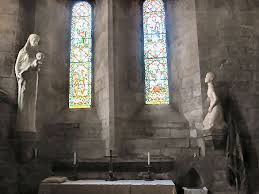 Sculptures of Holy Theotokos with Christ Child and St. Bega in St. Bees Priory
Sculptures of Holy Theotokos with Christ Child and St. Bega in St. Bees Priory One day during a drunken brawl three men accidentally killed another man and were imprisoned. In jail they were soon filled with remorse, repented of their sins and started imploring the holy Abbess Bega to help them. The holy maiden miraculously saved them from incarceration and the former criminals found shelter in her convent. The fetters from which the men had miraculously been released were kept at the nunnery for a long time afterwards. Another time two sick brothers (one of them was a paralytic, the other one suffered from an ulcer), the sons of a certain Frenchman, were sent on a cart to St. Bega’s convent after a miraculous vision seen by their father in the town of Tynemouth. Both brothers received healing immediately on arriving at the holy place. As a token of their gratitude, the healed men donated their cart to the convent.
The convent founded by St. Bega (later called St. Bees Priory) kept records of all the miracles that occurred there. Thus, in 1310 “the Lord worked many miracles through the prayers of St. Bega for the edification of the faithful in the presence of a huge number of people: the blind recovered their sight, the dumb began to speak, lunatics were granted sanity, those suffering from dropsy were healed of it”. And three years later “eyesight returned to a certain Irish boy on Holy Friday inside St. Bega’s Chapel through the prayers of this holy virgin in the presence of the whole of the congregation”. In this way, the holy abbess, who in her lifetime was loved for her generosity and care for the needy and the oppressed, did not abandon them after her repose.
For many years the bracelet of St. Bega was kept at her convent and it was said that it had been given her by an angel in Ireland: numerous miracles happened near this relic. In the Middle Ages there was a custom to take oaths on the bracelet (this practice still existed in the thirteenth century).
Apart from the village of St. Bees in Cumbria (the original name: Kirkby Becok) St. Bega was also venerated at the Abbey of St. Mary the Virgin in the city of York and in other places. The convent founded by Bega was most likely destroyed by Danish raiders. It was then refounded as a Roman Catholic Benedictine priory for men in about 1130 (in fact Norse Vikings settled in Cumbria in the tenth century; in all probability there was no more than a church with secular canons in St. Bees before the foundation of the Norman priory). It was a monastery dependent on the York Abbey of St. Mary. Life in St. Bees Priory flourished particularly in the fourteenth and fifteenth centuries, though the priory suffered raids by the Scots in about 1216 and also in 1315 (Cumbria is situated near the Scottish border; the Scots from time to time attacked many northern English monasteries in the Middle Ages). Veneration for St. Bega in St. Bees Priory continued until the Reformation, when the monastery was dissolved in 1539. After the Reformation, the nave, tower and transepts of the former monastery were used as a parish church. This Norman Church in honor of the Mother of God and St. Bega survives here to this day and pilgrims visit it. The priory church has a stained glass depicting a scene from the life of St. Bega along with a collection of splendid stone carvings of various religious figures. A partly-surviving early tenth-century cross stands in the priory churchyard; part of a similar early English cross is preserved in the church. Recent archaeological excavations have enabled researchers to learn more of the history of the monastery. Later biographers of St. Bega mentioned that a certain village of Kilbees in Scotland was named after Bega.
Two other Cumbrian churches (in addition to the priory of St. Bees) are dedicated to St. Bega: one of them is very ancient, the other one is recent. The first is situated in the tiny village of Bassenthwaite (original name: Beokirke), near the town of Keswick, in a remote and beautiful setting, typical for early hermits. This unique church dates approximately to the year 950. Some historians state that this church is somehow directly associated with the life and activity of St. Bega. The church stands in the fields near the shore of Bassenthwaite Lake, some distance from the village itself. It is open daily and visited by pilgrims during the year. In the past it inspired English poets such as William Wordsworth (1770-1850; much of his work is inspired by the Lake District) and Alfred Lord Tennyson (1809-1892). The church keeps copies of the Bible in twenty-eight different languages for foreign guests. It is one of only a few pre-schism churches still existing and functioning in Cumbria—a living link with early Orthodoxy in the UK. The second of the churches, a very small church in honor of St. Bega, can be found in the tiny village of Eskdale Green (located in the Eskdale valley in an idyllic area); it was built in the late nineteenth century.
Formerly many more churches were dedicated to St. Bega in the north of England and Scotland, for example, in the hamlet of Ennerdale (near the lake by the same name) in Cumbria, in the hamlet of Kilbucho in the Scottish Borders area of Scotland (where the ruins of an early church and a holy well of St. Bega still exist) and on the island of Little Cumbrae (whose name means “the church of a female saint”) in the Firth of Clyde in North Ayrshire. Bega is also the patron-saint of Kilbagie (Fife) and Kilbegie (Argyll and Bute) in Scotland, where monasteries were dedicated to her.
In western Cumbria there is a 36-mile walk known as “St. Bega’s Way” which begins at the Norman Priory of St. Mary the Virgin and St. Bega in St. Bees and ends near the early English St. Bega’s Church in Bassingthwaite, in the beautiful rural scenery of Cumbria and the Lake District. “St. Bega’s Way” is also called “a pilgrimage”; thus this saint of God is still commemorated in this ancient way as well.
Holy Virgin and Anchoress Bega, pray to God for us!

